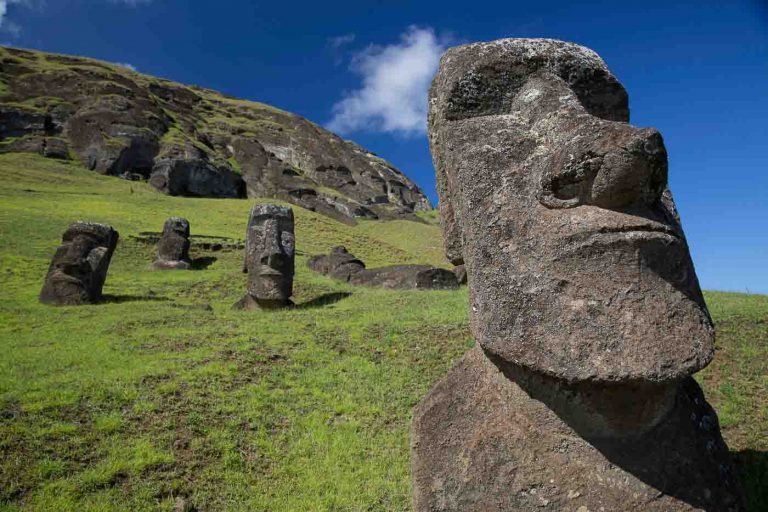Our "Bucket List" of Ancient Art Destinations
The world is full of of outdoor ancient art, sites where past civilisations have created magnificent works of art for reasons we can only speculate about. We've put together a wishlist of 10 distinctive art destinations, each of which could be the centrepiece of an art-lover's trip. The Nazca Lines of Peru and the Ajanta Caves in India are our favourites, but all 10 are special in their own right.
If you visit even a few of these places, you may well be left pondering why their creators felt the urge to leave their mark this way. If you are, you'll be in good company, joining the many people who have asked the big, timeless question:
What is Art Really For?
Looking back from our comfortable 21st Century lifestyles, it may be hard to understand why early humans bothered creating ancient art. Decorating tools, daubing colour on cave walls, or building sculptures too heavy to move, you'd think they’d be too busy dodging dinosaurs or preparing for bad weather.
But of course that simple view doesn’t reflect what’s as valid today as it was then:
The pursuit of things we don’t have to do simply to survive is part of what makes us humans.
From art to religion, from storytelling to sport, it’s the “optional extras” in life that consume most of our attention, and perhaps define us as as a species.
How Important is Art Compared to Food?
If you’re familiar with Maslow’s Hierarchy of Needs, you’ll know that our basic behaviours are driven by first sorting out fundamental biological and physiological needs – like food, warmth, shelter and sex.
Even when these are in place, we are still motivated by “safety” needs like security and protection from the elements. It’s only after we’ve sorted out these basics that we’re meant to worry about what Maslow describes as “social”, “esteem” and “self-actualisation”.
But this understates the importance of relating to each other, relating to a higher being or purpose, and dealing with death and what lies after it.
Religion, art and interacting with society are arguably as fundamental to human life as food and security. More accurately, life with the latter is not really complete (or perhaps worthwhile) until we have the former.
10 Great Places to See Ancient Art
Wikipedia distinguishes Ancient Art from Prehistoric Art – roughly speaking art from cultures before they became literate. We’ve been a more flexible in our definitions.
What we’ve looked for in this article is outdoor art from tens of thousands of years ago (as opposed to hundreds of thousands) up to around a thousand or so. The focus is on pieces you can visit today, and see up close – art destinations around which to plan great trips in their own right.
We've picked each ancient art destination for two reasons, over and above the fact that they are interesting to anyone with even a passing interest in ancient art.
- Firstly, we have picked art destinations that help show us what art meant to a particular group of people in the past. For example, the Ajanta Caves in India are full of religious images, but the purpose of the caves is probably to house a set of colleges or monasteries.
- Secondly, we've tried to look for something distinctive about each chosen art destination, especially if it's somewhat offbeat. For example, the Nazca Lines in Peru are of great importance to anyone who believes human civilisation is a result of visits to Earth from aliens, bestowing upon us their technology!
Here are the 10 outdoor ancient art destinations we've selected for you.
Destination 1: Nazca Lines, Peru
Nazca Lines - the World's Largest Art Installation?
In the Nazca Desert of Southern Peru you'll find about 300 drawings of humans, birds and animals so large they only be seen in full from the air, although you do get a pretty good view from the top of nearby hills.
These drawings (known as biomorphs and geoglyphs) span over 500 square kilometres, some of them spanning tens or even hundreds of metres wide. They take our prize for the world's largest art installation.
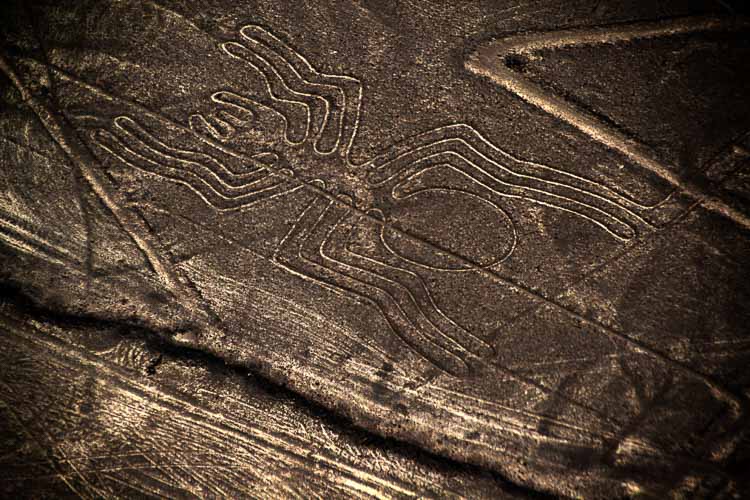
A Nazca image in the form of a Spider
Deceptively Simple to Make
This ancient art is named after the people who created them over 2,000 years ago - the Nazca culture. It's perhaps surprising that they've lasted so long, as they're made fairly simply by removing the surface layer of reddish stones, exposing the grey-white ground underneath.
The secret is the still, arid climate, where hardly any wind is around to disturb these huge monuments to what we assume is a religious purpose. It's also possible that the limestone-rich soil that forms the lines hardens when exposed to damp morning mists, adding extra natural protection.

This Nazca line is probably the largest picture of a Monkey you'll ever see
But Terribly Difficult to Plan
The other fascinating question around this art destination is how the Nazca people could create such large designs so accurately with the tools and facilities of the time. For example, the 93m hummingbird, 134m condor, 93m monkey and 47m spider.
The answer is probably a combination of geometry, grids, basic surveying tools and patience! If you're at all interested in the detail, you'll enjoy Joe Nickell's account of how 3 generations of his family spent a wet August weekend recreating a Nazca Condor in Kentucky.
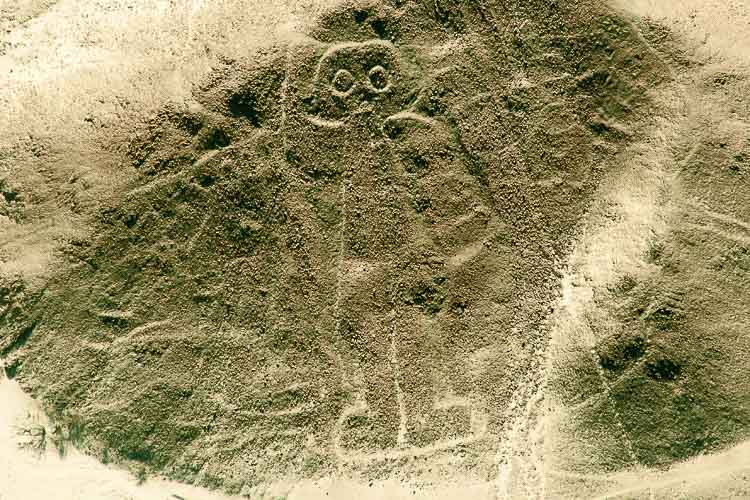
The Nazca "Astronaut" depicts a man, but some see it as evidence of aliens visiting Earth!
A Treat if You Believe Alien Life Visited Earth!
There are some relatively serious suggestions to be found questioning if flight was involved. One theory is that the Nazca people developed hot air balloons. But if you're going down that path of thinking, we think you ought to do it properly, and prefer how Erich von Daniken gave credit to visiting astronauts from other planets. You may not be surprised to know film rights to his book were bought, and a documentary made. But did you know an Austrian firm explored building a theme park around von Daniken's book?!
Unfortunately, after surviving nature for so long, the Nazca lines are now starting to deteriorate because of modern mankind. Squatters are reported to have started living in the area in recent years, and their presence is causing the lines to become disturbed.
This is not an uncommon story for ancient outdoor art - after surviving nature for centuries or longer, many works of art struggle to cope with a few years of human attention.
Destination 2: Easter Island Statues
The World's Heaviest Art Installation?
Around 900 huge statues on Easter Island have given the island its claim to fame for outdoor ancient art. Known as Moais, some weigh in at over 80 tonnes, and are up to 10m in height. And it's estimated that one of the unfinished statues found would have weighed around 3 times that if completed.
The statues are sometimes known as the Easter Island Heads because of the prominent, attention-grabbing heads, but each of them is actually a whole body.
The pieces were believed to have been carved out of rock walls of a volcanic quarry called Rano Raraku. Most are made of a material called "tuff", a compressed vocanic ash.
Unfortunately much of that has worn over time, and the best preserved examples are the minority made from basalt or other rocks. It's not clear how they were carved, but we're fairly sure the shaping and smoothing was done using pumice.

Up close, you appreciate not just the achievement of the art, but also its transportation around the island
Moving The Moais - A Mystery of Ancient Engineering
At over 1,000 years old, they're relatively modern compared to some of our selections, but are still old enough to give cause for some great unknowns. Like most ancient art works, the reason the Polynesians built them is still a mystery.
But perhaps more intriguing is how their creators - the Rapa Nui people - coped with the massive weight of the stones, both to make them and move them to their final home. Many of them were transported to the perimeter of the island, distances of up to around 10km.
There have been a few attempts to recreate this feat by modern academics. The conclusion is that it took ropes, wooden sledges and lots of human muscle power to create this stunning art destination.
Here's an entertaining National Geographic video showing 5 theories for how the stones were moved:
An Enigmatic History With More Questions Than Answers
There is plenty of fascinating reading on the detail around the Moai statues. For example there was a class structure around who was allowed to carve them, and the quarry was divided amongst different clans.
Why the Easter Island statues stopped being built is also a bit of an enigma, with evidence of an abrupt end to work while many pieces were still being built. Again, there are many theories, some of course fanciful.
The demise of the Rapa Nui with the arrival of Western traders and missionaries means there is little oral or written history left, so we have no real clues to what happened, just speculation and imagination.

No one is sure why they are different sizes, or what the sizes represent
Whatever You Do, Don't Chip Off a Moai Ear
From the late 1950s to early 1970s, erosion and pollution damage started to be reversed through the efforts of archaeologists, and by 1972 the UN included it as part of the world's heritage to be protected.
In 1994 UNESCO declared the Rapa Nui National Park a World Heritage site, and the Chilean government (under whom the islands fall) have been taking its protection very seriously. A Finnish tourist who chipped a piece off a Moai ear was fined $17,000 and banned from the island for 3 years.
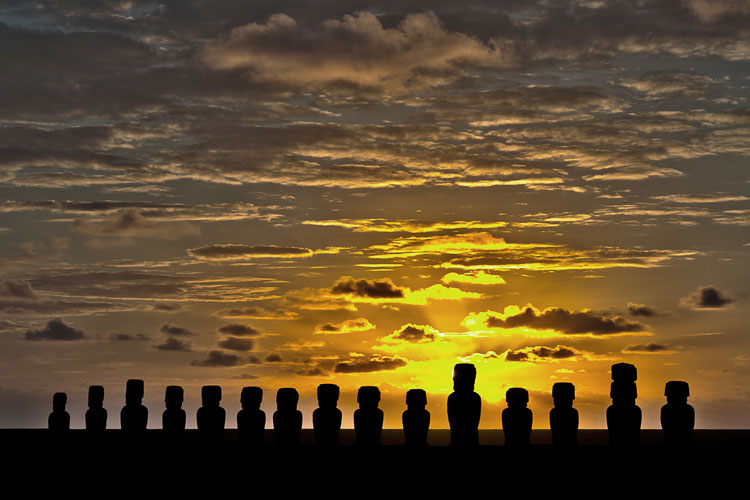
Destination 3: Petroglyphs of America
There is ancient art directly onto rock all over the world. If it's made by scraping away the surface layer, it's known as rock carving or engraving, but for some reason if it's in North America it's called a Petroglyph.
These examples from Utah and Nevada are some of oldest around, dating back about 15,000 years.

Ancient symbols texture, Petroglyphs on Newspaper Rock, Utah, USA.
An Early Form of International Language?
Some believe that ancient petroglyphs are a form of language, because of the way certain symbols are repeated. Regardless of what they might mean, one curiosity is that these symbols are found in different parts of the worlds, in places where the people of the time couldn't have been in touch with each other.
That may well be co-incidence, but it's also possible that groups of early humans might have travelled from a single place, repeating the designs of their ancient art on rocks in their new homes. If that's the case, then petroglyphs are a map of early human migration patterns.
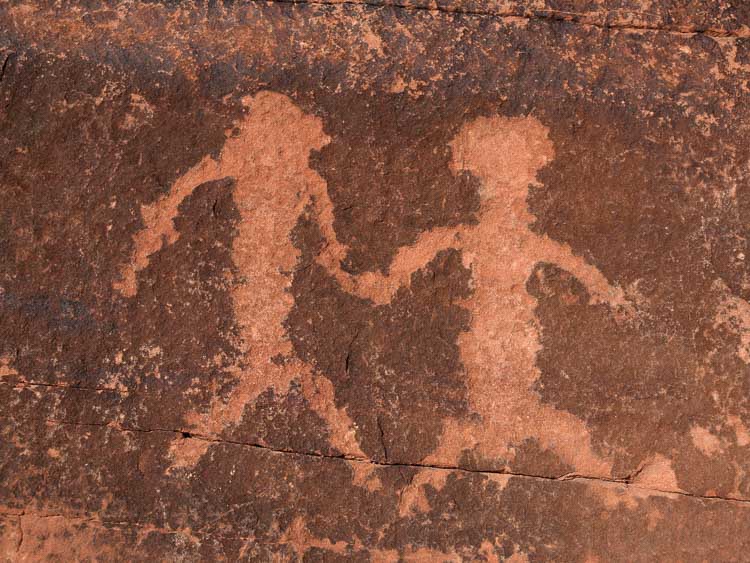
Ancient American Indian petroglyph on a red sandstone wall.
Evidence of the First Legal High?
Less scientific, but more interesting, is the theory that these images were created by early humans while under the influence of natural drugs! This idea comes from investigating the repeating geometric patterns, some of which are similar to patterns that also occur when we're in an altered state of consciousness. In other words, during hallucinations brought on by drugs and migraines.
In case you think this a bit fanciful, there's a plenty of academic material on this, not least because the patterns (known as geometric forms) are mathematically interesting. One paper on the topic of geometric visual hallucinations includes the link to Petroglyphs (perhaps because it's from the University of Utah), and is surprisingly readable.
Destination 4: Stonehenge, England
This mysterious prehistoric ancient art monument was constructed between 3000-2000 BC. A possible burial site and a monument to the dead, Stonehenge is a unique, enigmatic art destination.
We love how the Stonehenge official website describes it as "the World's Favourite Megalithic Stone Circle"!
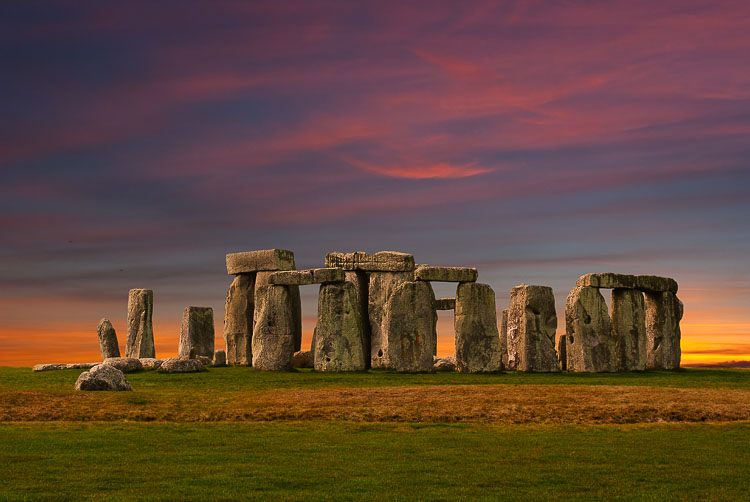
Stonehenge at sunset
If You Think Your Builders Are Slow . . .
The first part of construction started involved digging a circle of ditches and holes, probably for ceremonial religious purposes. However, there was then a break of around 1,000 years before the builders got round to fill the holes!
In this case, they used a set of bluestones, each weighing around 4 tonnes. For some reason, they felt they couldn't use anything nearby, so chose to transport the rocks from Wales, around 200 miles away.
The combination of ropes, pulleys and rafts made for an onerous journey, but it was nothing special compared to their counterparts on Easter Island.
The next stage of construction was only a couple of hundred years later, when much bigger stones were placed in an outer circle. As these were nearly ten times heavier, the creators decided local material would be good enough, so only had to drag them a mere 25 miles from the nearby Marlborough Downs.
We estimate today those final rocks would have taken around 500 people to drag using leather ropes, with another 100 people moving wooden rollers from the back to the front.
They then took a well-deserved 500 year break, before re-arranging the stones to form the ancient art pattern we see today. By then there were around 60 bluestone rocks in place, but many of those have broken up or been removed since then, and some only remain as stumps.

The classic Stonehenge silhouette image
Temple, Parliament, Cemetery or Hospital?
Academics from the UK and Austria conducted a detailed four year underground survey of the area under and around Stonehenge, using radar and other imaging techniques. Their fascinating results threw up a whole new set of theories about what Stonehenge was used for.
The most important finding was the evidence of so much activity immediately around the circle. It was a veritable hubbub, including over a dozen other monuments, spread over around 4 square miles.
Destination 5: Lascaux Paintings, France
Some of the man’s oldest painting to be discovered are seen in this picturesque part of France. The paintings in this ancient art destination go back about 17,000 years. It is probably the earliest use of red pigment to create colour in the paintings.
We've highlighted two things about the Lascaux Caves that piqued our interest, the subjects painted and the way the caves are organised.

The First Technically Accomplished Artists?
There are around 2,000 paintings, grouped into animals, people and abstract symbols. The animals are mostly horses and stags, with a few cattle and bison, together with the occasional cat, bird and even rhinoceros. One 5m bull painting is the largest cave painting of an animal yet discovered.
The creators of this ancient art showed surprising technical competence in their art, for example showing bulls in motion on some of the pictures. One of the most interesting details from an art technique viewpoint is the first example of perspective in ancient art - in the form of crossed hind legs.
What's much less clear is how the people living in this art destination chose what to paint. The obsession with horses isn't quite clear, and more curious still is the absence of creatures more common than the chosen subjects. The most glaring omission is the reindeer, a very common neighbour. And yet they chose to paint at least one stag.
The First Themed Art Gallery?
Archeologists have spent six decades investigating the complex network of caves that form this art destination, and named several sections based on the themes of the paintings in them.
This seems to be an ancient art version of how a modern art gallery is arranged. For example, the National Portrait Gallery in London groups its works by historical period (Tudor & Elizabethan, Georgian, 20th Century etc). We don't know how the artists of Lascaux referred to their sections, but modern scientists have given them names like the Great Hall of the Bulls, the Lateral Passage, the Shaft of the Dead Man, the Chamber of Engravings, the Painted Gallery, and the Chamber of Felines.

If You Want to Preserve Ancient Art, Keep Modern Man Away
A perennial feature of so many art destinations that have lasted centuries or longer, is that they start to struggle to survive once modern man gets involved.
In the case of Lascaux, it's not just the effects of tourists and camera flashes. Since the year 2000, black fungus has started to blight some of the pictures. While some believe this is because of lights and visitors, others blame the installation of a new air conditioning system designed to preserve the site!
Destination 6: Commagene Statues of Nemrut, Turkey
Now part of Turkey, this art destination used to be part of the kingdom of Commagene, a small Armenian monarchy that only lasted a few hundred years, just over 2,000 years ago. Sitting in between several large, powerful states, its brief existence arose as one great empire that controlled it declined (the Seleucids), and the next one to absorb it was rising (the Romans).
Its diverse mix of people meant that there was no clear cultural identity to celebrate. Instead, the legacy of this kingdom to humankind was built by its most famous King, Antiochus I, as a monument to himself!
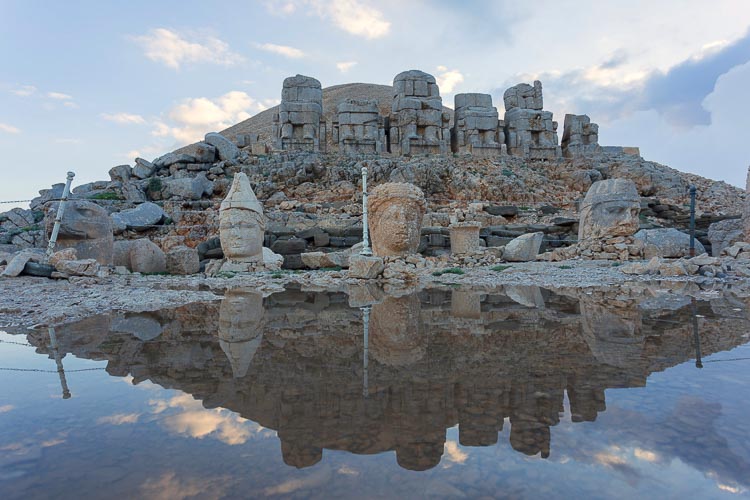
The large statues at the top of Nemrut mountain in southeastern Turkey. mountain.
The Most Ego-centric Art Destination in the World?
It's safe to assume Antiochus I had an ego the size of a small planet. He called himself the God King, claiming a special relationship with the gods. Much of his time on Earth was making preparations to be worshipped after his death. For example, he started a form of Zoroastrianism centred on himself.
If it wasn't for his desire to be worshipped, we wouldn't have this magnificent art destination to see today. He built a religious sanctuary on Mount Nemrut for people to come and pray to him. He chose the 2,100m mountain so he could be close to his peers, the gods. He also wanted it visible to his whole kingdom.
The temple became his tomb, and is based on a 50m high pyramid-shaped mound of stones, surrounded by 8m statues of himself. He also erected several other statues of gods and animals, but the heads of these were removed at some point, and now lie scattered over the site.
Antiochus I would have been disappointed to know that his people's memory of him was short-lived, and subsequent rulers had their own tombs and monuments built on the same site.
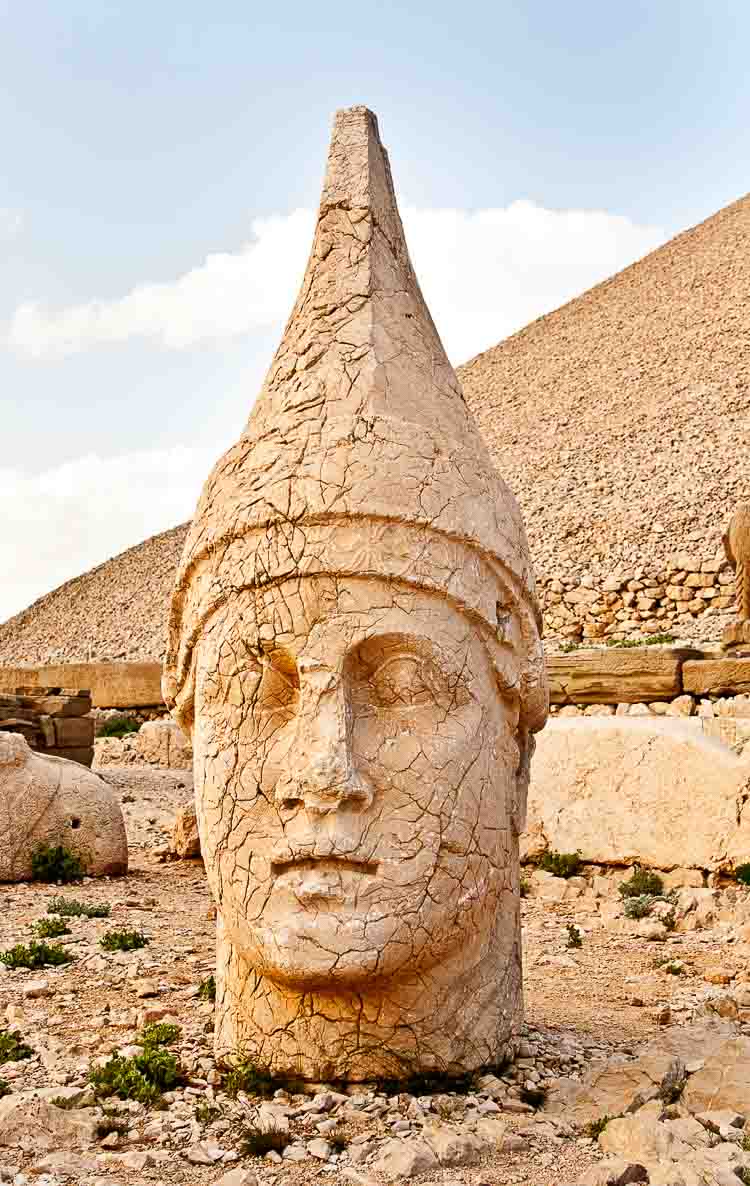
Statue details preserved despite their age
The First Example of Multiculturalism in Art?
What makes Mount Nemrut distinctive compared to other burial monuments of large statues is the diversity of cultures represented, reflecting Antiochus' heritage and the illustrious Commagene history.
He was the first ruler we know of to unite East and West in one bloodline, with Macedonian and Greek maternal descent from Alexander the Great, and paternal links to Persian King Darius the Great.
He also had a liberal approach to the influences on his beliefs, integrating a variety of eclectic cultural and religious philosophies. For example, he practised a form of astrology which links back to the Hermetic movement of the Greeks, and redefined the Commagene year using concepts from ancient Egypt.
All of this and more is shown in the art he created. Scientists believe his statues included Greek, Armenian and Persian gods, from Zeus and Apollo to Oromasdes and Mithras. Furthermore, the fashionistas of the day would have recognised Greek facial features, but Armenian clothing and hairstyles. As far as the astrology is concerned, one stone shows stars and planets in alignment. Incidentally, these have been identified as Jupiter, Mercury and Mars, and their alignment has helped scientists to date the site to 62 BC.
Destination 7: Twyfelfontein Rock Art, Namibia
Located near a spring, Twyfelfontein has rock art going back 6,000 years. It depicts a diverse set of animals including rhino, elephant, giraffe, oryx, ostrich, flamingo, zebra as well as animal and human foot prints.

Rock carvings in Twyfelfontein include rhinoceroses, elephants, ostriches, also human & animal footprints.
A 2,000 Year Diary
One of the reasons UNESCO declared this a World Heritage site is that it is a well preserved record of the life of hunter-gatherer peoples in southern Africa over at least 2,000 years.
This is because of the geography of this art destination. It lies between desert, savanna and shrubland and despite the presence of the spring after which it's named, receives very little rain. The area is in a valley between sandstone table mountains, so the carvings are on sandstone rocks. These rocks are covered by a protective brown layer, sometimes called desert varnish - similar to the protection on the Nazca lines.
Unlike Nazca, it took much more effort to create the Twyfelfontein lines, chiseling through the hard patina to uncover the lighter rock underneath. They were created over several thousand years by different local inhabitants, and consist of three main images: pictures (of animals, humans, and fantasy creatures), symbols (circles and dots), and signs of everyday use (grinding hollows and even early board games).
UNESCO describes these as:
a coherent, extensive and high-quality record of ritual practices relating to hunter-gatherer communities . . . [it] eloquently illustrates the links between the ritual and economic practices of hunter-gatherers.
The Largest Outdoor Art Gallery in Africa?
The art is spread over 15 sites, some named more imaginatively than others, but non particularly creative:
- Twyfelfontein Main Site; Place of Ceremonies; North of the Place of Ceremonies
- Seven Slabs; Seven Slabs Outlier; Hare Rock Block; Boulder Field
- Large Living Area; Southern Living Area; Right Valley Side; Left Valley Side
- Western Hill Slope; Bottom of Western Hill; At Large Paint Block; At Large Paint Block Outlier
There are two natural paths through these. One is known as the 'Lion Man' guided route, named after the impressive engraving of a five-toed lion with prey in its mouth. As well as giraffes, rhinos, antelopes and elephants, there are also seals and flamingoes - so the artists had knowledge of far-away places.
More Signs of Early Hallucinogenic Drugs?
The other trail is named 'Dancing Kudu', which refers to the transformation of humans into animals.
This is a reference to early shamans, who were believed to put themselves into a state of ritual trance, and take on the spirit of the animals represented in the rock art.
Some of the pictures are of this part-human, part-animal transition, particularly into the species of antelope known as Kudu. It also explains apparent "inaccuracies" in some of the pictures, such as lions with 5 toes.
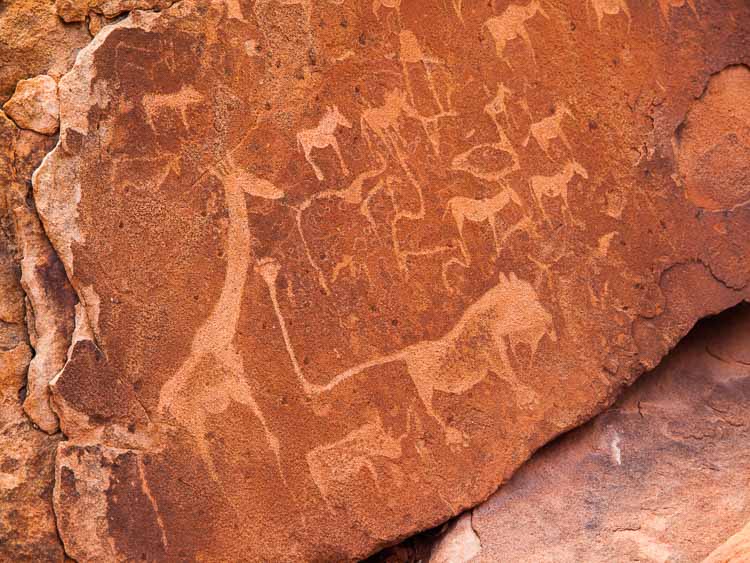
Lion Plate with Lion Man and other animals and symbols, Twyfelfontein, Namibia
Unfortunately, the presence of modern humans is taking its toll on this art destination too, with the appearance of graffiti as one of several threats facing this rich heritage. UNESCO pushed the Namibian government hard to take protective steps, and in recent years these seem to have made a difference.
Destination 8: Ajanta Caves, India
The Ajanta caves contain Buddhist art, consisting of beautiful sculptures and some of the oldest paintings found in India. They date back to the 2nd century BC, and are of enormous historic, cultural and religious significance. They are also the home of some evocative, intriguing art.
Carved into the side of a horseshoe shaped mountain face by a river, the complex of 30 caves were abandoned over 1,500 years ago, only re-discovered in the 1800s by a British soldier on a tiger hunt.

A Chaitya Griha (prayer hall) at Ajanta Caves
A Worldwide Buddhist Destination for Silence, Meditation & Education
The Ajanta Caves appear to have been created as a contemplative space in which to meditate and consider the teachings of Buddha. There are records of visitors from all over India and the rest of the world, including China. This included monks returning to the Ajanta Caves during monsoon seasons.
But over time, the role of the Ajanta Caves changed, and it became an internationally renowned centre for Buddhist education. The prayer spaces came to be outnumbered by rooms for monastic education and living, as word spread to Buddhist disciples and scholars around the world.

Mural painting in Ajanta Caves
Art That Celebrates Life & Pleasure (and Shocked the Victorians)
One of the reasons we are such fans of the Ajanta Caves is the vibrancy of the art, both form and intent. The caves are filled with beautiful, colourful paintings all around, including on walls and ceilings.
Colour was created using a natural pigments such as ochre and malachite. There was also decoration with gemstones, many of which were brought to the Ajanta Caves from far afield, such as Lapis Lazuli from Afghanistan. One of the mysteries of the art is how such wonderful colours could be seen and used in such a dark setting. The great benefit of this to us is that the colours have been preserved by the darkness.
There are many cues in the art to other eras and influences, both past and future. For example, elements of classical Greek art in paintings and architecture, use of Fresco techniques seen in European Renaissance work, and references to Chinese culture in some of the subject matter.
However, most of the Ajanta Caves is filled with uniquely Indian art in style and subject. And some of this is where the Victorians had a bit of an issue.
As well as depicting the life of Buddha, many pieces told stories from oral and written tradition, including scenes of mythological, history, royalty and daily life. The art was a celebration of the beauty of divine life, including sensuous and sensual images of glamorous princes and princesses living life to the full.
For the Victorians, some aspects of the joy of these lives was too much. The paintings included depictions of lives of pleasure, with people enjoying life at its most joyous, as it were . . . These were condemned British men of religion, unable to accept or agree with this alternative approach to art meeting religion.

Bodhisattva Padmapani Painting inside the Ajanta caves , India
Regardless of your attitude to the subject matter, the Ajanta Caves give us an unparalleled insight into India's ancient artistic heritage. The sculptures, murals and paintings are a marvel, and make an excellent excuse to plan a trip to the India.
Destination 9: Terracotta Army, China
The Terracotta Army is one of the most magnificent ancient finds in the last 50 years. From the Qin Dynasty of the second century BC, the sheer scale of the army of life-size sculptures is a sight to behold.
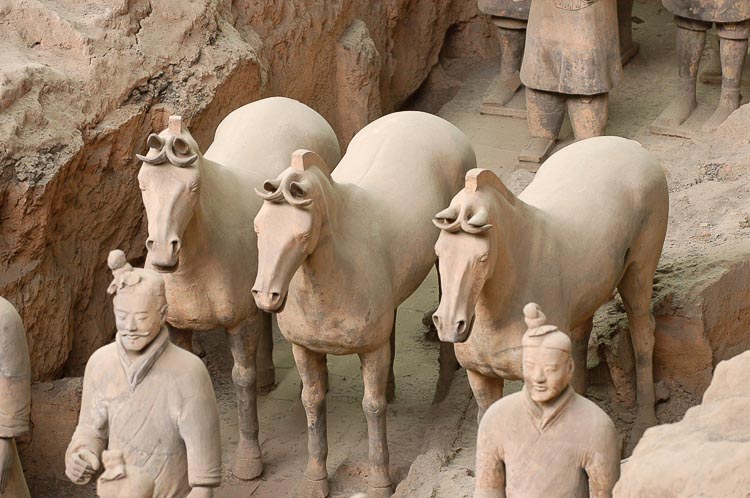
Xian Terracotta Warriors
A Full Size Army for Protection in the Afterlife
The purpose of the Terracotta Army is clear from its Chinese name, which translates as "Soldier-and-horse funerary statues". This collection of nearly 10,000 sculptures was meant to represent the armies of the first Emperor of China, Qin Shi Huang, to be buried with him to protect him in life after death.
The vast majority were solders, along with chariots and horses. However, there were also a number of non-military figures buried with the army, including officials, musicians and acrobats.
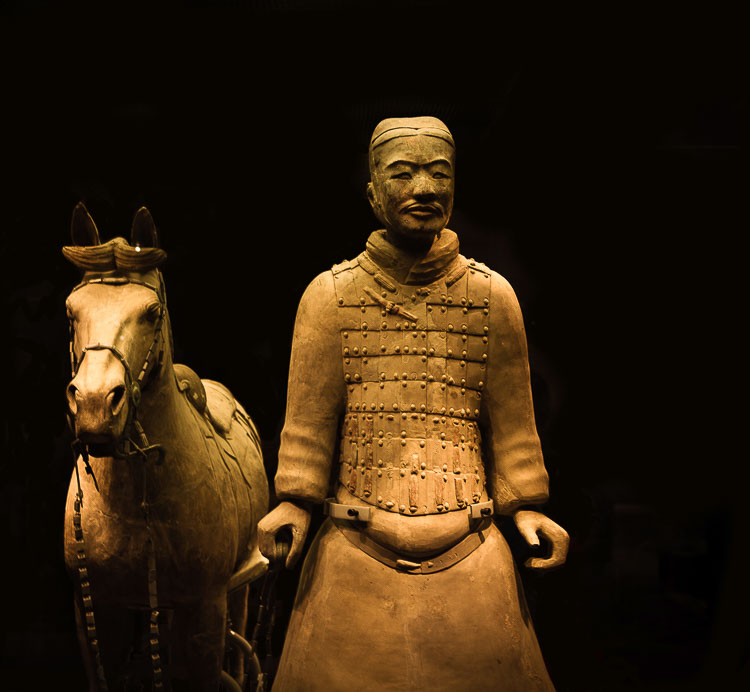
The fine detail on a carving
Yet Part of a Much Bigger Construction
Perhaps the most astounding feature of this at destination is not its sheer scale, but that according to some writings and findings, the army was just a small part of a much bigger construction!
Sima Qian was an early Chinese historian, who wrote extensively on the First Emperor. He reported that a necropolis was built around the first emperor's tomb mound.
Qin Shi Huang’s complex was built as a full sized model of the imperial palace. It consisted of structures his palace would need to function in the afterlife, including offices, dining halls and stables. It's hard to get a sense of scale of this, even knowing that the entire Terracotta Army we see today merely formed a guard to one side of the tomb.
A more stark illustration is Sima Qian's claim that work on the mausoleum involved 700,000 workers, and it was decorated simulations of flowing rivers made of mercury. There remains debate about his writing, but there were reported to be high levels of mercury in the nearby soil during recent studies.
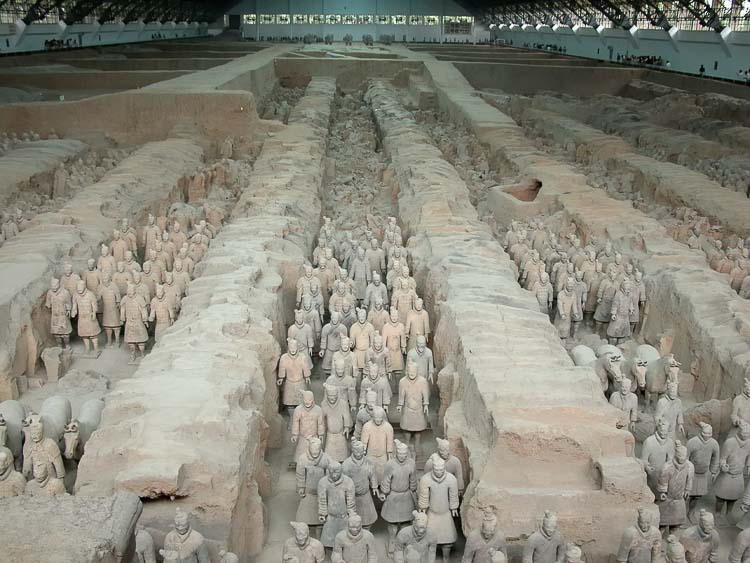
The scale of the art is hard to comprehend
The First Art to be Made on a Production Line?
Made from yellow clay found locally, the skill of the sculptors can be admired even two millenia later. This is despite the fact that the lacquer colours have long faded, such is the detail of the pieces.
However, with the large numbers involved, it was going to be an unprecedented challenge to maintain the quality and consistency required for a whole army of artwork. To address this, they built workshops for local craftsmen to create parts, like limbs and torsos, which were then assembled elsewhere separately.
Consistency of the faces was probably achieved by creating a set of face moulds, using them to add faces in clay to heads after assembly. The fact that each component was made and fired separately before final putting together means it is classed as an assembly line, albeit a high quality one - a first for artwork.
Destination 10: Kimberley Rock Art, Australia
Some of the oldest outdoor art on the planet is to be found on rocks under ledges in Kimberly, Western Australia. The paintings there is generally accepted to be up to 20,000 years old or so, although some have speculated that the origins of this rock art go back much further, possibly over 40,000 years.

Bradshaw Paintings at Kimberley
A History of Controversy
The Kimberly Paintings have a record of controversy since discovery by pastor Joseph Bradshaw in 1891. The story goes that Bradshaw was looking for suitable pastoral land in the area, and found unusual art painted onto local sandstone rocks. He was familiar with the Wandjina art previously discovered by Grey, and felt these were different.
The controversy is predominantly about regarding the age of the paintings and who created it. In particular, academics have interpreted data found in the area as possible evidence that the paintings are much older than the 15,000 to 20,000 years that most scientists believe.
The reason this has caused controversy is because it has led to suggestions that the artists behind this work may have pre-dated the Aboriginal Australians who have lived in the area for such a long time. It's a sensitive topic for many obvious and less obvious reasons, and has tainted some opinions of the art itself. It has also led to some politicising the artwork and its heritage.
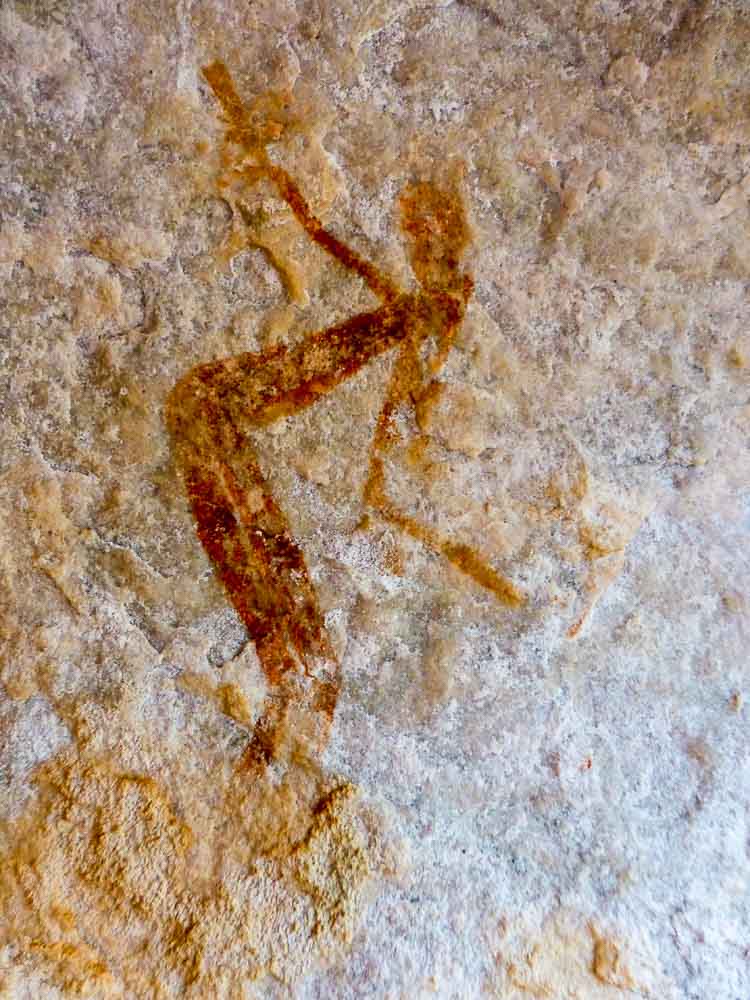
This rock art is also known as Gwion Gwion
Ancient Art That We Can Ask the Painters' Descendants About?
One of the most curious possibilities about ancient art is that the descendants of the art's creators could still be around today, potentially with an oral or even written record of the story of the art. It really would be something special if the story of a piece of the earliest art had been handed down alongside it.
The Aboriginal Australians are one of the cultures that has managed to retain strong links to its past, including cultural and art traditions. So the combination of Kimberly's Bradshaw Rock Paintings and Aboriginal Australian storytelling history left us optimistic. We hoped to discover more than just speculation from archaeologists, scientists and historian.
We were disappointed to not be able to find any reliable references to anyone asking today's Australian Aborigines about the art, or the role of their ancestors in its creation. We did find a somewhat intriguing mention on the well-regarded Creative Spirits website:
Aboriginal elders say they know nothing about Bradshaw paintings; they were done by “different people to us”.
The art has been relatively well preserved over the years, but unfortunately there has been a high incidence of graffiti over and around the paintings.
This is a list of places to see outdoor ancient art across the various continents. There was something exciting about seeing thing that were similar across continents and in a similar time period. It equally intriguing to begin to wonder about the reasons behind some of these – why did our forefathers want to create some of these and how did they do it?
Perhaps early humans would look at us today and watch as we commute, pay bills, shop and visit doctors, and conclude that our lives aren’t that different to theirs. They might completely understand why for many of us, what matters most is the other stuff – holidays, TV, worship, football, nightclubs, the theatre.
And so their biggest curiosity might be why we wonder why they created such spectacular ancient art.


